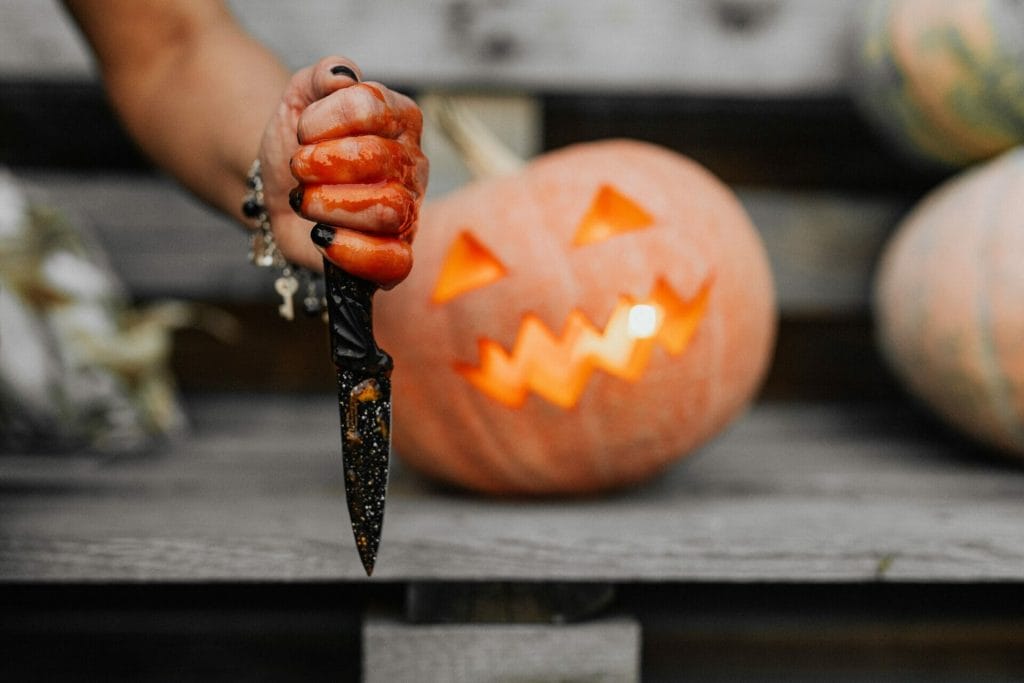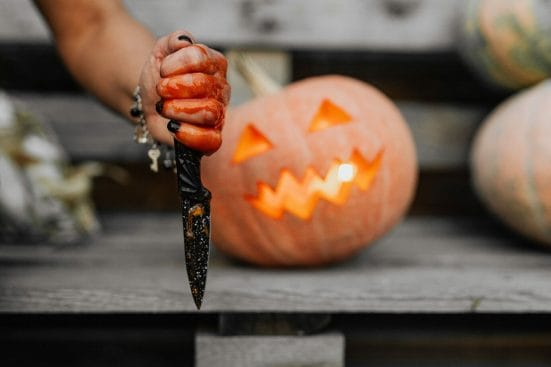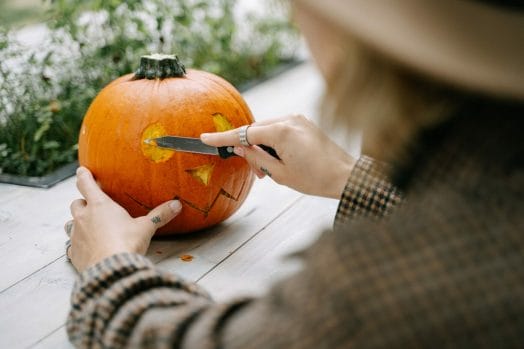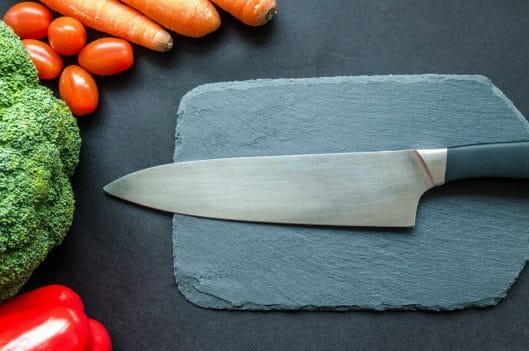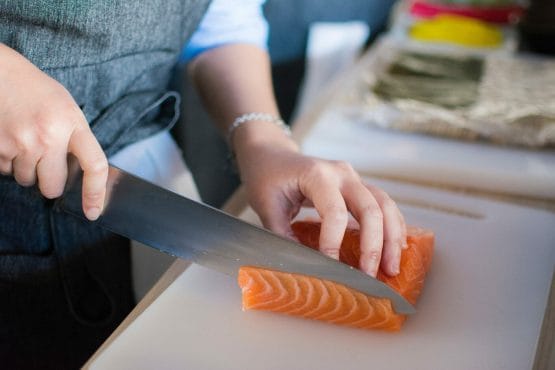Carving Knife vs Chef Knife
To understand the differences between a carving knife vs chef knife, you need to consider their unique blade shape, length, and thickness. These distinctions will determine the type of tasks that each knife is best suited for. In this section, we will explore these differences, starting with the blade shape and moving on to blade length and thickness.
Blade Shape
1. The shape of the blade distinguishes a carving knife from a chef’s knife. The blades on carving knives are longer and thinner than those on chef knives.
2. Let’s look at some differences in blade shape between these two types of knives. In terms of length, carving knives can range from 8 inches to 15 inches, while chef knives usually measure between 6 and 12 inches. As for width, carving knives have narrower blades than chef knives. The bevels on carving knives are also optimized for slicing rather than chopping.
Additionally, the pointed tip of a carving knife allows you to cut through larger cuts of meat with a smooth slicing motion. Conversely, chef knives have curved edges ideal for chopping vegetables.
Pro Tip: Understanding the subtle differences in blade shape between a carving knife and a chef knife can help save time and improve efficiency in the kitchen.
A chef’s knife is like a samurai sword, while a carving knife is more like a butter knife in comparison.
Blade Length
With regard to the length of the blade, there are distinct differences between carving knives and chef knives.
| Blade Length | Carving Knife | Chef Knife |
|---|---|---|
| Length | 8 to 15 inches | 6 to 14 inches |
Carving knives have a longer blade length that ranges from 8 to 15 inches, which is suitable for cutting through larger portions of meat. On the other hand, chef knives have a shorter blade length, ranging from 6 to 14 inches.
It’s important to note that while blade length is a key factor in distinguishing these two types of knives, there are other differences as well. For instance, carving knives generally have thinner blades that are perfect for slicing meats and poultry with ease, whereas chef knives have thicker blades designed for chopping and dicing vegetables.
The history of knife-making can be dated back to around 2.5 million years ago when prehistoric humans created rudimentary cutting tools from stones and animal bones. Over time, this primitive technology has evolved into the sophisticated cutlery we use today.
Thick or thin, it’s all about the precision of the slice – just don’t ask the knife if it’s feeling a little thick around the handle.
Blade Thickness
The thickness of the cutting edge differs between Carving and Chef knives. This variation plays a significant role in their performance on different foods.
For instance, a Carving Knife that typically measures about 1/16 inch thick is best suited for slicing roasted meats like turkey or ham, while a Chef Knife with an approximate thickness of 1/8 inch is excellent for chopping vegetables and fruits.
To give you a visual comparison, refer to the table below that details the thickness of standard carving and chef knives:
| Type of knife | Blade Thickness |
|---|---|
| Carving Knife | 1/16 inch |
| Chef Knife | 1/8 inch |
It’s worth mentioning that while blade sharpness is essential for both types of knives, the difference in blade thickness significantly impacts its function.
Additionally, Carving Knives usually feature a longer and thinner blades than Chef knives. The length allows users to make precise cuts without sawing back and forth, while the thinness provides greater flexibility to carve large meats effortlessly.
Interestingly, Japanese-style carving knives known as Yanagiba or Sujihiki have even thinner blades than traditional carving knives used in Western cuisines. They come with an extremely sharp single bevel that glides through raw fish like butter, ideal for sushi chefs.
Historically, Chef knives date back to Germany in the late 19th century when they were first created by legendary German blacksmiths J.A Henckels and Wusthof Trident. In contrast, carving knives’ origins can be traced back to ancient times when people specifically used them for meat carving during religious celebrations.
A carving knife is to meat what a surgeon’s scalpel is to a patient – precise and deadly.
Carving Knife Characteristics
To understand the distinguishing qualities of a carving knife, you need to slice, meat-cut, and carve with it. This section on “Carving Knife Characteristics” will give you a thorough insight into the knife’s unique features and benefits. You’ll learn everything from its sharpness to the blade’s size, which caters to precise meat-cutting, and how it differs from a chef knife.
Slicing
When it comes to the art of slicing, precision, and control are key. The knife used for this purpose should be sharp, well-balanced, and lightweight. A blade length of 8 to 10 inches is ideal to ensure consistent cuts. A thinner blade will allow for smoother slicing while a thicker one will provide stability. For the ‘Slicing’ section, let’s create a table detailing the necessary features of a good carving knife:
| Feature | Description |
|---|---|
| Blade shape | Long, narrow, and straight |
| Blade edge | Firm but not too thick |
| Handle | Ergonomic shape that offers comfort and superior hand position |
| Blade type | Stainless steel or Carbon steel |
| Blade length | The range of 8 to 10 inches |
It’s important to consider the material your knife is made of; while stainless steel resists corrosion, carbon steel is known for sharper edges. When selecting your carving knife, it’s all about considering what works best for you. It can take time to find the perfect tool that fits your grip and preferences. Remember that even professional chefs need to experiment with different knives before settling on their go-to. I once saw a renowned chef use an old-fashioned bread knife instead of a standard carving knife for Thanksgiving dinner. He explained that he preferred its serrated teeth for more delicate meat slicing. It was fascinating seeing how he put his own spin on traditional techniques! Meat cutting is a delicate balance between precision and not losing a finger. Choose your carving knife wisely.
Check out some best carving knives here!
Meat Cutting
Cutting meat requires specific characteristics in a carving knife. The blade must be sharp, long, and narrow with a pointed tip. A comfortable handle also aids precision in meat cutting.
A well-designed table for meat cutting includes columns for the type of meat, desired thickness, weight, and appropriate carving knife to use. This enables better efficiency when slicing meats and prevents injury from using an improper knife.
When selecting a carving knife for bone-in meats, opt for a heavier-duty blade such as a cleaver or boning knife. For boneless cuts, a thin-bladed carving knife is ideal to ensure clean cuts and minimal shedding.
Pro Tip: Always keep your blade sharp and avoid using a dull knife as it can lead to uneven cuts and potential accidents.
Carving: the culinary art of turning a hunk of meat into something that looks like it belongs in a fancy restaurant…or something that your cat wouldn’t even touch.
Carving
Carving involves the precise cutting of meat, poultry, or fish into slices that are aesthetically appealing and easily consumable. This culinary art requires specific tools such as carving knives that can make clean and sharp cuts.
Here’s a 6-step guide to carving:
- Start by placing the meat on a large cutting board and securing it with a fork.
- Use a sharp carving knife with a narrow blade to make thin, even slices.
- Begin at the thinnest end of the meat and continue slicing towards the thicker end.
- If there is any bone-in meat, utilize a boning knife or kitchen shears to carefully remove any bones before slicing.
- To serve roast birds or game birds, begin by removing the wings followed by carving along each side of the chestbone.
- Make sure all slices are uniform in thickness for an attractive presentation.
It’s vital to remember to take safety precautions when carving because even a little carelessness could lead to serious injury. Always ensure that you have a firm grip on your knife and protect your other hand from possible accidents. Do not forget to hold your cutting board steady so that it does not slip while you’re carving.
According to Good Housekeeping magazine, carving knives should be sharpened at least once or twice per year to guarantee optimum performance.
You can slice, dice, and julienne like a pro with these chef knives…just be careful not to lose a finger or two in the process.
Chef Knife Characteristics
To master chef knife characteristics for carving knife vs chef knife, the focus is on the knife’s blade, shape, and design. This section explores the features that make a knife perfect for chopping, slicing, and dicing different foods.
Chopping
While handling a chef knife, you may need to perform ‘dice-cutting’ of vegetables, fruits, and meats. To chop the ingredients correctly, holding the knife properly and having control while applying force are essential.
Here is a five-step guide on how to handle a chef knife for chopping:
- Hold the knife with a firm grip on the handle.
- Put your other hand on top of the blade and use it as a guide for precision.
- Rock your wrist back and forth while bringing down the knife onto the ingredient to create small uniform pieces.
- Repeat until you have chopped all of the ingredients according to the desired size.
- Clean your workstation after use.
It’s crucial to note that dull knives are more dangerous than sharp ones. Sharpening your chef knives regularly can help prevent accidents.
A tip worth considering is that each ingredient requires varying levels of force when chopping. Some may require more pressure than others, such as denser root vegetables or meat compared to softer produce like tomatoes. Be sure to adjust accordingly.
According to a study by Consumer Reports in 2018, about 330,000 people go to emergency rooms for kitchen knife injuries annually in America.
Slice the competition with a chef’s knife that cuts through anything, except maybe a steel beam.
Slicing
For the art of ‘Slicing’, a chef’s knife must fulfill certain Characteristics. The blade’s sharpness, length, and thickness are crucial for an accurate cut that doesn’t damage the food’s texture or composition. To ensure top-notch slicing, choose a knife with a comfortable handle that gives you better control over the blade’s movement.
| CHARACTERISTIC | DESCRIPTION |
|---|---|
| Blade sharpness | A razor-sharp blade is necessary to precisely slice through various kinds of foods without tearing them. |
| Blade length | Longer blades make quick work of sizable items like watermelon or bread loaves while shorter blades excel at small items such as garlic cloves and radishes. |
| Blade thickness | Thinner blades make clean cuts, but thicker ones are needed for denser foods like squash or dense fruits like coconuts. |
Choose a chef knife with a unique smooth curve on its edge that allows for efficient cutting motions with minimal fatigue on hands and wrists. Professional chefs use knives with slightly staggered teeth along the blade’s front to keep it from sticking to moist food surfaces.
The Samurai were notorious slicers in medieval Japan, referring to their knives as “daishō.” In this classification system, two swords serve distinct purposes: the long katana and the short wakizashi. Similarly, slicing is an indispensable weapon in every chef’s culinary arsenal.
Ready, set, dice – the only time it’s socially acceptable to pretend your cutting board is your nemesis.
Dicing
Slicing into small, uniform shapes is an essential skill for a chef. Various cutting techniques are employed in dicing, which includes finely minced foods to larger cuts for stews and braises.
| Technique | Description |
|---|---|
| Classic Dice | Cubes measuring 1/4-1/2 inch on each side. This results in a uniformly-sized cut that cooks evenly. |
| Batonnet Dice | Thick strips that are approximately 1/4 inch in width and height and 2 inches in length. Ideal for fried dishes or hearty soups where the vegetables need to retain their shape even after prolonged cooking. |
| Macedoine Dice | Smaller than classic dice with cubes measuring 1/8-1/4 inch on each side. Perfect for garnishes, fruit salads, and risottos |
| Julienne Dice | Thin matchstick-shaped strips that are around 1/8 inch wide by 2-3 inches long, used for stir-fries and Asian-style salads |
A few unique details concerning dicing include ensuring the blade is kept straight when slicing through the ingredient and making sure it’s done all the way through without any partial cuts.
When dicing ingredients always keep them uniform in size to ensure even cooking times. Start by setting your knife blade at a consistent angle as you dice your food ingredient throughout evenly while avoiding twisting or applying pressure. Choose the correct size depending on how large of pieces you desire to cook with, having well-sharpened knives ensures quicker precision work reducing unnecessary waste.
Choosing the right knife is like choosing the right partner, it may take some trial and error but once you find the perfect match, everything becomes smooth and effortless.
Also, read our popular articles:
Sharpening Knives for Survival: Tips and Tricks
5 Best Japanese Chef Knives Under 100 in 2023
Choosing the Right Knife
To choose the right knife for your kitchen, solve the dilemma of Carving Knife vs Chef Knife, and consider their purpose, frequency of use, and personal preference. Delve into these sub-sections to better understand which knife is best for your culinary needs.
Purpose
Knives play a crucial role in cooking and other activities that involve cutting and slicing. Investing in the right knife is essential to optimize your experience. To make informed decisions when choosing a knife, consider the following points:
- Blade Material – Choose high-quality materials like stainless steel or carbon steel for durability and long-lasting sharpness
- Blade Shape – Different blade shapes serve different purposes. Chef’s knives are ideal for general-purpose use, while serrated knives are suitable for bread and tomatoes
- Handle – A comfortable grip enhances precision and safety. Look for a handle that fits well in your hand, offers a non-slip grip, and has an ergonomic design
- Maintenance – Consider the ease of maintenance since some materials require more upkeep than others. For example, stainless steel blades are easy to maintain but can dull quickly if not sharpened regularly.
- Budget – Your budget will also affect your decision. It’s worth investing more in quality knives that will last longer.
In addition to the above factors, it’s crucial to select the right size of knife based on your needs and preferences.
Historically speaking, knives have played significant roles throughout history dating back to ancient civilizations where they served various purposes from hunting animals to self-defense. Even today, knives continue to be significant tools in our daily lives beyond their common purpose as cutlery.
Choosing the right knife based on the frequency of use – unless you’re a serial killer, then just go for the sharpest one.
Frequency of Use
The frequency of knife usage is a crucial factor to consider when choosing the right knife for your needs. Take into account the number of times you use a knife daily, weekly, or monthly to ensure that your chosen knife will meet your demands adequately.
- For frequent use, invest in a durable and high-quality knife with a sturdy handle that can withstand long hours of slicing and chopping.
- If you only use knives occasionally, choose an affordable yet reliable option.
- A serrated blade is ideal for slicing through bread or tomatoes frequently.
- Kitchen knives used daily require regular sharpening to maintain their cutting-edge performance.
- Chef’s knives are versatile tools that can handle a wide range of cutting tasks and are suitable for those who often cook at home.
- If using knives outdoors while camping or hiking, opt for compact folding blades that can easily fit into a backpack or small pouch.
When selecting the perfect knife, it’s also vital to consider factors such as handle comfort, blade size, material quality, and weight distribution. Keep these points in mind while evaluating different options to find the ideal fit for your requirements.
An interesting fact about knives is that they have been around since early civilization and were initially made out of stone. Egyptians were one of the first civilizations to develop metal-bladed knives around 3000 BCE. Knife-making has evolved over the years with new materials and techniques being used to produce high-quality knives suitable for various purposes. Keep reading our blog article on Carving Knife vs Chef Knife.
A knife is like a soulmate, you just gotta find the one that feels right in your hand and always has your back in the kitchen.
Personal Preference about Carving knife vs Chef knife
The best knife for you is determined by your individual tastes and needs. Your preferred handle material, blade design, and weight distribution are all factors to consider when selecting a knife that feels natural in your hand. Check out different types of knives available and find one that fits your comfort level.
Consider trying a few styles of knives before deciding on the one that suits you best. A popular option is a chef’s knife, suitable for slicing, dicing, and chopping. However, if you’re frequently slicing fresh bread or cutting through bone-in meats, you might prefer something with a serrated edge or a more robust blade design.
In addition to the physical aspects of the knife itself, your personal style can play an essential role in finding the right tool for the job. Some people opt for highly decorated blades while others prefer simple designs with rustic handles. Ultimately, it’s up to you to determine what feels comfortable and looks appealing in your kitchen.
Did you know? Different types of metals have unique properties that make them ideal for certain uses. For example, carbon steel makes excellent razor-sharp blades but requires more maintenance than stainless steel varieties due to its tendency towards rusting.
Sharpening your knife is like therapy for both the blade and your psyche – cathartic and satisfying.
Check out some chef knives here!
Maintenance and Care
To maintain and care for your carving knife and chef knife effectively, it’s essential to understand their differences. In this section discussing maintenance and care, we’ll cover the specific solutions associated with the different features of the two knives. Sharpening, cleaning, and storage will be briefly introduced to help you achieve optimal functionality and longevity of your knives. Enjoy reading our blog article on Carving Knife vs Chef Knife.
Sharpening
To maintain and care for your tools, it’s crucial to keep them sharp. Proper sharpening enhances tool performance and prolongs their lifespan. Here is how you can perform Sharpening like a pro:
- Securely hold the damaged or dull tool in a vice-grip or clamp.
- Start with a lower grit abrasive, then use higher grit abrasives gradually.
- Keep the blade at a consistent angle while applying pressure across the sharpening surface.
- Remove any burrs using a honing stone in case of blades/tools.
- Cleanse off any debris after sharpening with water and wipe dry with a clean towel.
Sharpening is an essential step in maintenance and care, and proper technique ensures that your tools remain effective for longer periods of time. Ensure that you practice caution when handling sharp tools.
Pro Tip: Always remember to use Personal Protective Equipment (PPE), such as safety glasses, gloves, and hearing protection when appropriate.
Cleaning is like putting lipstick on a pig, it may look better but it’s still a pig.
Cleaning
Performing upkeep and maintenance of living space is crucial to make sure it remains in good shape. Undertaking regular cleansing tasks is essential to do so.
- Use appropriate cleaners for specific materials.
- Wipe surfaces clean after every use.
- Clean upholstery with fabric cleansers suited for its material.
- Vacuum carpets frequently to remove dirt and dust buildup.
- Don’t forget to disinfect shared surfaces to minimize the spread of germs.
To ensure that your cleaning efforts are efficient, it’s best to hire professional cleaning services occasionally for a complete top-to-bottom deep clean.
Studies have shown that regular cleaning can help improve mental well-being by reducing stress levels and promoting relaxation.
Store your tools properly or they’ll end up as rusty relics in a museum of neglect.
Storage
Maintaining and preserving your belongings is essential to ensure their longevity. Regarding the long-term safety of your items, safeguarding them during storage is crucial. Here are some tips to maintain high value and quality.
| Item | Type of Storage | Tips |
| Clothing | Inside Closet or Wardrobe | Avoid Plastic Bags; Use Natural Fabric Covers. Store Seasonally. |
| Furniture | Climate-Controlled Storage Unit | Disassemble If Possible; Wrap in Protective Materials. |
| Silverware & Jewelry | Lined Drawer or Jewelry Box | Avoid Humid areas and Chemical Exposure; Clean and Polish Before Storing. |
Additionally, it would be wise to secure your stored items’ space by labeling and organizing them systematically. Carrying out routine cleaning before storing possessions is beneficial, especially for equipment with moving parts.
These storage solutions have proven helpful over time, particularly for antiques. However, in modern times, self-storage businesses have become more trendy than most other storage options.
One historic example of people prioritizing proper object care – In ancient Egypt (3150-30 BCE), wealthy families adorned their buried relatives’ tombs with worldly objects deemed valuable enough to aid the deceased in the afterlife. The tombs had a secured entrance that opened onto an anteroom where offerings were displayed on shelves in niches. Later tombs included more extensive facilities such as a chamber with cabinets for items like furniture, lamps, and jewelry. Thanks for reading our blog article on Carving Knife vs Chef Knife.
